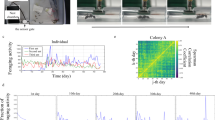Abstract
An ant colony shows collective behavior through signal patterns formed by individual ants communicating among themselves. In this paper I devise a method for designing ant colony model and apply the method to design two types of ant colonies, focusing on ant sensitivity to signals. In the first type, I design three foraging models (trail, attraction and desensitization), by modifying a simple foraging model repeatedly, changing ant sensitivity to recruit pheromone to improve foraging by regulating allocation of ants. Out of them, the desensitization model shows the best foraging efficiency as a result of balanced allocation and stable behavior. In the second type, I design a task-allocation model between foraging and mound-piling tasks using independent signals for each task. It shows weak interaction between these tasks.
Preview
Unable to display preview. Download preview PDF.
Similar content being viewed by others
References
Nakamura, M., Kurumatani, K.: Formation mechanism of pheromone pattern and control of foraging behavior of an ant colony. In: Langton, C.G., et al. (eds.) Artificial Life V, pp. 64–77. MIT Press, Cambridge (1997)
Stephens, D.W., Krebs, J.R.: Foraging theory. Princeton University Press, Princeton (1986)
Gordon, D.M.: Ants at work, pp. 143–147. W. W. Norton Company, New York (2000)
Deneubourg, J.-L., et al.: Probabilistic Behavior in Ants; A Strategy of Errors? J. Theor. Biol. 105, 259–271 (1983)
Author information
Authors and Affiliations
Editor information
Editors and Affiliations
Rights and permissions
Copyright information
© 2005 Springer-Verlag Berlin Heidelberg
About this paper
Cite this paper
Nakamura, M., Kurumatani, K. (2005). A Method for Designing Ant Colony Models and Two Examples of Its Application. In: Capcarrère, M.S., Freitas, A.A., Bentley, P.J., Johnson, C.G., Timmis, J. (eds) Advances in Artificial Life. ECAL 2005. Lecture Notes in Computer Science(), vol 3630. Springer, Berlin, Heidelberg. https://doi.org/10.1007/11553090_54
Download citation
DOI: https://doi.org/10.1007/11553090_54
Publisher Name: Springer, Berlin, Heidelberg
Print ISBN: 978-3-540-28848-0
Online ISBN: 978-3-540-31816-3
eBook Packages: Computer ScienceComputer Science (R0)




